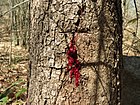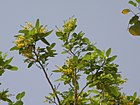Note: This is a project under development. The articles on this wiki are just being initiated and broadly incomplete. You can Help creating new pages.
Difference between revisions of "Pterocarpus santalinus - Lohitachandana"
(→Common names) |
|||
| (16 intermediate revisions by 2 users not shown) | |||
| Line 1: | Line 1: | ||
| − | [[File: | + | [[File:Pterocarpus santalinus - Köhler–s Medizinal-Pflanzen-114.jpg|thumb|right|Ane golaganji]] |
| − | + | '''Pterocarpus santalinus''' is a perennial and non-climbing species of leguminous tree. Its uses include food, drink and timber. | |
| − | |||
==Uses== | ==Uses== | ||
| − | {{Uses| | + | {{Uses|Acne}}, {{Uses|Wrinkles}}, {{Uses|Chronic bronchitis}}, {{Uses|Gonorrhoea}}, {{Uses|Blotches}}, {{Uses|Pimples}}, {{Uses|Diarrhea}}, {{Uses|Sore throats}}, {{Uses|Wounds}}, {{Uses|Inflammation}}, {{Uses|Headache}} |
==Parts Used== | ==Parts Used== | ||
| − | {{Parts Used|Flowers}}, {{Parts Used| | + | {{Parts Used|Flowers}}, {{Parts Used|Stem}}. |
==Chemical Composition== | ==Chemical Composition== | ||
| − | Phytochemical investigations of aqueous and ethanol extracts of stem bark revealed the presence of alkaloids, phenols, saponins, glycosides, flavonoides, triterpenoides, sterols, and tannins <ref name="chemical composition"/> | + | Phytochemical investigations of aqueous and ethanol extracts of stem bark revealed the presence of alkaloids, phenols, saponins, glycosides, flavonoides, triterpenoides, sterols, and tannins.<ref name="chemical composition"/> |
==Common names== | ==Common names== | ||
| − | {{Common names|kn=Ane | + | {{Common names|kn=Ane gulaganji|ml=|sa=Ksharaka, Kunchandana|ta=Ani kundamani|te=Gurivenda, Enugaguruginji|hi=Rakt chandan|en=Red sandalwood, Coral-wood}} |
==Properties== | ==Properties== | ||
| Line 31: | Line 30: | ||
==Habit== | ==Habit== | ||
| − | {{Habit|Deciduous | + | {{Habit|Deciduous tree}} |
==Identification== | ==Identification== | ||
| Line 38: | Line 37: | ||
===Flower=== | ===Flower=== | ||
| − | {{Flower|Unisexual|1.5 c.m| | + | {{Flower|Unisexual|1.5 c.m|White|10|Very numerous, with a small tinge of yellow. United near the base but soon dividing into two parcels of 5 each}} |
===Fruit=== | ===Fruit=== | ||
| Line 46: | Line 45: | ||
==List of Ayurvedic medicine in which the herb is used== | ==List of Ayurvedic medicine in which the herb is used== | ||
| − | * [[ | + | * [[Asanadi kashayam]] |
| + | * [[Guduchyadi kashayam]] | ||
| + | * [[Tarunarka rasa]] | ||
| + | * [[Chandanadi lauh]] | ||
| + | <ref name="Ayurvedic preparations"/> | ||
==Where to get the saplings== | ==Where to get the saplings== | ||
| Line 53: | Line 56: | ||
==How to plant/cultivate== | ==How to plant/cultivate== | ||
| − | + | The seeds retain their viability for about one year under normal storage conditions and are the best propagation material. Fruits are collected in March for the extraction of seeds.<ref name="How to plant/cultivate"/> | |
==Commonly seen growing in areas== | ==Commonly seen growing in areas== | ||
| − | {{Commonly seen|Tall grasslands}}, {{Commonly seen|meadows}}, {{Commonly seen|Borders of forests and fields}}. | + | {{Commonly seen|Tall grasslands}}, {{Commonly seen|At meadows}}, {{Commonly seen|Borders of forests and fields}}. |
==Photo Gallery== | ==Photo Gallery== | ||
<gallery class="left" caption="" widths="140px" heights="140px"> | <gallery class="left" caption="" widths="140px" heights="140px"> | ||
(Pterocarpus santalinus) red sandalwood tree at IG Zoo Park in Visakhapatnam 01.jpg | (Pterocarpus santalinus) red sandalwood tree at IG Zoo Park in Visakhapatnam 01.jpg | ||
| − | |||
(Pterocarpus santalinus) red sandalwood tree at IG Zoo Park in Visakhapatnam 02.jpg | (Pterocarpus santalinus) red sandalwood tree at IG Zoo Park in Visakhapatnam 02.jpg | ||
(Pterocarpus santalinus) red sandalwood tree at IG Zoo Park in Visakhapatnam 03.jpg | (Pterocarpus santalinus) red sandalwood tree at IG Zoo Park in Visakhapatnam 03.jpg | ||
| Line 72: | Line 74: | ||
==References== | ==References== | ||
| − | |||
<references> | <references> | ||
| − | <ref name="chemical composition">[https://www.ncbi.nlm.nih.gov/pmc/articles/PMC4791987/ | + | <ref name="chemical composition">[https://www.ncbi.nlm.nih.gov/pmc/articles/PMC4791987/ Pharmacology]</ref> |
| − | + | <ref name="Leaf">[http://www.floraandfona.org.in/Uploaded%20Pdf/211/55-59.pdf Morphology]</ref> | |
| − | <ref name="Leaf">[http://www.floraandfona.org.in/Uploaded%20Pdf/211/55-59.pdf " | + | <ref name="Ayurvedic preparations">[https://easyayurveda.com/2015/12/16/raktachandan-red-sandalwood-uses-research-side-effects/ Ayurvedic preparations]</ref> |
| − | + | <ref name="How to plant/cultivate">[http://vikaspedia.in/agriculture/crop-production/package-of-practices/medicinal-and-aromatic-plants/pterocarpus-santalinus Cultivation details]</ref> | |
| − | <ref name="How to plant/cultivate">[http:// | ||
</references> | </references> | ||
| Line 85: | Line 85: | ||
* [https://www.flowersofindia.net/catalog/slides/Red%20Bead%20Tree.html Pterocarpus santalinus on flowers of india] | * [https://www.flowersofindia.net/catalog/slides/Red%20Bead%20Tree.html Pterocarpus santalinus on flowers of india] | ||
* [https://www.ncbi.nlm.nih.gov/pmc/articles/PMC4791987/ Therapeutic Potential of Pterocarpus santalinus L] | * [https://www.ncbi.nlm.nih.gov/pmc/articles/PMC4791987/ Therapeutic Potential of Pterocarpus santalinus L] | ||
| − | * [http://nopr.niscair.res.in/bitstream/123456789/9403/1/NPR%203%282%29%2083-84.pdf | + | * [http://nopr.niscair.res.in/bitstream/123456789/9403/1/NPR%203%282%29%2083-84.pdf Pterocarpus santalinus on nopr.niscair.res.in] |
| − | |||
| − | |||
[[Category:Herbs]] | [[Category:Herbs]] | ||
| + | [[Category:Fabaceae]] | ||
Latest revision as of 10:18, 21 July 2020
Pterocarpus santalinus is a perennial and non-climbing species of leguminous tree. Its uses include food, drink and timber.
Contents
- 1 Uses
- 2 Parts Used
- 3 Chemical Composition
- 4 Common names
- 5 Properties
- 6 Habit
- 7 Identification
- 8 List of Ayurvedic medicine in which the herb is used
- 9 Where to get the saplings
- 10 Mode of Propagation
- 11 How to plant/cultivate
- 12 Commonly seen growing in areas
- 13 Photo Gallery
- 14 References
- 15 External Links
Uses
Acne, Wrinkles, Chronic bronchitis, Gonorrhoea, Blotches, Pimples, Diarrhea, Sore throats, Wounds, Inflammation, Headache
Parts Used
Chemical Composition
Phytochemical investigations of aqueous and ethanol extracts of stem bark revealed the presence of alkaloids, phenols, saponins, glycosides, flavonoides, triterpenoides, sterols, and tannins.[1]
Common names
| Language | Common name |
|---|---|
| Kannada | Ane gulaganji |
| Hindi | Rakt chandan |
| Malayalam | |
| Tamil | Ani kundamani |
| Telugu | Gurivenda, Enugaguruginji |
| Marathi | NA |
| Gujarathi | NA |
| Punjabi | NA |
| Kashmiri | NA |
| Sanskrit | Ksharaka, Kunchandana |
| English | Red sandalwood, Coral-wood |
Properties
Reference: Dravya - Substance, Rasa - Taste, Guna - Qualities, Veerya - Potency, Vipaka - Post-digesion effect, Karma - Pharmacological activity, Prabhava - Therepeutics.
Dravya
Rasa
Tikta (Bitter), Kashaya (Astringent)
Guna
Laghu (Light), Ruksha (Dry), Tikshna (Sharp)
Veerya
Ushna (Hot)
Vipaka
Katu (Pungent)
Karma
Kapha, Vata
Prabhava
Habit
Identification
Leaf
| Kind | Shape | Feature |
|---|---|---|
| Simple | 35 inches long, have 57 leaf lets long, margin wavy and obtuse |
Flower
| Type | Size | Color and composition | Stamen | More information |
|---|---|---|---|---|
| Unisexual | 1.5 c.m | White | 10 | Very numerous, with a small tinge of yellow. United near the base but soon dividing into two parcels of 5 each |
Fruit
| Type | Size | Mass | Appearance | Seeds | More information |
|---|---|---|---|---|---|
| 7–10 mm | Clearly grooved lengthwise, Lowest hooked hairs aligned towards crown | {{{6}}} |
Other features
List of Ayurvedic medicine in which the herb is used
Where to get the saplings
Mode of Propagation
How to plant/cultivate
The seeds retain their viability for about one year under normal storage conditions and are the best propagation material. Fruits are collected in March for the extraction of seeds.[4]
Commonly seen growing in areas
Tall grasslands, At meadows, Borders of forests and fields.
Photo Gallery
References
External Links
- Ayurvedic Herbs known to be helpful to treat Acne
- Ayurvedic Herbs known to be helpful to treat Wrinkles
- Ayurvedic Herbs known to be helpful to treat Chronic bronchitis
- Ayurvedic Herbs known to be helpful to treat Gonorrhoea
- Ayurvedic Herbs known to be helpful to treat Blotches
- Ayurvedic Herbs known to be helpful to treat Pimples
- Ayurvedic Herbs known to be helpful to treat Diarrhea
- Ayurvedic Herbs known to be helpful to treat Sore throats
- Ayurvedic Herbs known to be helpful to treat Wounds
- Ayurvedic Herbs known to be helpful to treat Inflammation
- Ayurvedic Herbs known to be helpful to treat Headache
- Herbs with Flowers used in medicine
- Herbs with Stem used in medicine
- Herbs with common name in Kannada
- Herbs with common name in Hindi
- Herbs with common name in Tamil
- Herbs with common name in Telugu
- Herbs with common name in Sanskrit
- Herbs with common name in English
- Habit - Deciduous tree
- Index of Plants which can be propagated by Seeds
- Herbs that are commonly seen in the region of Tall grasslands
- Herbs that are commonly seen in the region of At meadows
- Herbs that are commonly seen in the region of Borders of forests and fields
- Herbs
- Fabaceae








